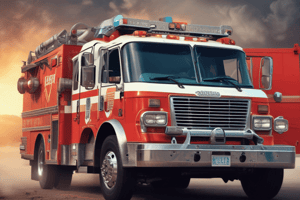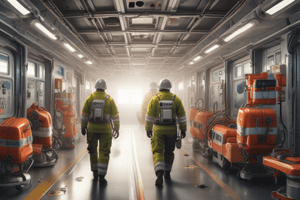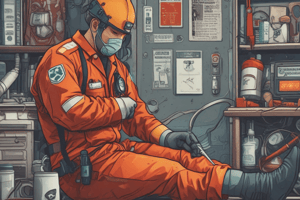Podcast
Questions and Answers
What is the primary focus during the stabilization of the scene in an emergency response?
What is the primary focus during the stabilization of the scene in an emergency response?
- Coordinating with other rescuers
- Assessing the patient's condition
- Transporting the patient to a medical facility
- Identifying hazards and available resources (correct)
What is a crucial aspect of access in an emergency response?
What is a crucial aspect of access in an emergency response?
- Removing the patient from the scene
- Transporting the patient to a medical facility
- Identifying hazards and considering safety (correct)
- Coordinating with other rescuers
What is the primary goal of traffic incident management in an emergency response?
What is the primary goal of traffic incident management in an emergency response?
- Providing medical care to the patient
- Coordinating with other rescuers
- Controlling traffic flow (correct)
- Ensuring swift patient removal
What is an example of a safety measure used to protect the rescue work area?
What is an example of a safety measure used to protect the rescue work area?
What is the importance of situational awareness in an emergency response?
What is the importance of situational awareness in an emergency response?
What is the final step in the emergency response process?
What is the final step in the emergency response process?
What is the primary focus of awareness level technical rescue training?
What is the primary focus of awareness level technical rescue training?
What is the primary role of EMS providers in special rescue situations?
What is the primary role of EMS providers in special rescue situations?
What is the goal of preparation in special rescue operations?
What is the goal of preparation in special rescue operations?
What is the role of operations level training in technical rescue?
What is the role of operations level training in technical rescue?
What is the primary responsibility of EMS providers assisting rescue team members?
What is the primary responsibility of EMS providers assisting rescue team members?
What type of training is required for EMS providers responding to special rescue situations?
What type of training is required for EMS providers responding to special rescue situations?
What is the primary focus of technician level technical rescue training?
What is the primary focus of technician level technical rescue training?
What is the purpose of the response step in special rescue operations?
What is the purpose of the response step in special rescue operations?
Study Notes
Vehicle Extrication and Special Rescue Techniques
- EMS departments must be prepared to respond to various special rescue situations, including vehicle extrication, collapse, confined space, trench, water, hazardous materials, agricultural incidents, and wilderness rescue.
- EMS providers must have formal education or training in rescue techniques to identify hazards, activate additional resources, and secure the scene.
Technical Rescue Incidents
- Technical rescue incidents involve complex rescues, such as vehicle extrications, water, ice, confined space, trench, structural collapses, high-angle and low-angle rescue, Hazmat, and wilderness search and rescue.
- There are three levels of TR training: awareness, operations, and technician.
- Awareness level training is introductory, focusing on identifying hazards and performing scene size-up, with no actual use of rescue skills.
- Operations level training applies limited technical rescue techniques, teaching paramedics to directly assist those conducting the operation.
- Technician level training involves direct involvement in the rescue operation, including equipment use, patient care, and incident management.
Assisting Rescue Team Members
- Be equipped, prepared, and ready with proper protective gear, equipment, and training.
- Coordinate with other rescuers and EMS providers, maintaining situational awareness and staying alert to potential threats.
- Work as a team, following the golden rule of public service: staying with the patient whenever possible and providing updates about the rescue actions.
Eight Steps in Special Rescue
- Preparation: train with other agencies, learn skills and equipment, and practice key terminology for better communication.
- Response: technical rescue teams respond with necessary equipment and personnel, potentially including a rescue squad, ambulance, fire engine, or chief officer.
- Arrival and scene size-up: gather critical information during the initial dispatch call, including location, incident nature, patient condition, and hazards.
- Stabilization of the scene: focus on crucial points related to the role, such as nature and scope of the incident, hazards, and available resources.
- Access: identify hazards and consider safety before approaching the patient or accident area.
- Disentanglement: consider traffic incident management, controlling traffic flow, and using high-visibility garments and safety measures.
- Removal: coordinate with other rescuers and EMS providers to ensure safe and efficient patient removal.
- Transport: follow established protocols for transporting patients to medical facilities.
Hazards and Safety
- Identify immediate and eventual threats, and maintain situational awareness to stay safe.
- Consider traffic incident management, using formal courses and crucial components to control traffic flow.
- Use safety measures such as flares, cones, flags, high-visibility garments, and scene lighting to protect the rescue work area.
Vehicle Extrication and Special Rescue Techniques
- EMS departments must be prepared to respond to various special rescue situations, including vehicle extrication, collapse, confined space, trench, water, hazardous materials, agricultural incidents, and wilderness rescue.
- Formal education or training in rescue techniques is necessary to identify hazards, activate additional resources, and secure the scene.
Technical Rescue Incidents
- Technical rescue incidents involve complex rescues, such as vehicle extrications, water, ice, confined space, trench, structural collapses, high-angle and low-angle rescue, Hazmat, and wilderness search and rescue.
- There are three levels of TR training: awareness, operations, and technician.
- Awareness level training focuses on identifying hazards and performing scene size-up, with no actual use of rescue skills.
- Operations level training applies limited technical rescue techniques, teaching paramedics to directly assist those conducting the operation.
- Technician level training involves direct involvement in the rescue operation, including equipment use, patient care, and incident management.
Assisting Rescue Team Members
- Rescuers should be equipped, prepared, and ready with proper protective gear, equipment, and training.
- Coordinate with other rescuers and EMS providers, maintaining situational awareness and staying alert to potential threats.
- Work as a team, following the golden rule of public service: staying with the patient whenever possible and providing updates about the rescue actions.
Eight Steps in Special Rescue
- Preparation involves training with other agencies, learning skills and equipment, and practicing key terminology for better communication.
- Response involves technical rescue teams responding with necessary equipment and personnel.
- Arrival and scene size-up involve gathering critical information during the initial dispatch call, including location, incident nature, patient condition, and hazards.
- Stabilization of the scene focuses on crucial points related to the role, such as nature and scope of the incident, hazards, and available resources.
- Access involves identifying hazards and considering safety before approaching the patient or accident area.
- Disentanglement involves considering traffic incident management, controlling traffic flow, and using high-visibility garments and safety measures.
- Removal involves coordinating with other rescuers and EMS providers to ensure safe and efficient patient removal.
- Transport involves following established protocols for transporting patients to medical facilities.
Hazards and Safety
- Identify immediate and eventual threats, and maintain situational awareness to stay safe.
- Consider traffic incident management, using formal courses and crucial components to control traffic flow.
- Use safety measures such as flares, cones, flags, high-visibility garments, and scene lighting to protect the rescue work area.
Studying That Suits You
Use AI to generate personalized quizzes and flashcards to suit your learning preferences.
Description
Learn about special rescue situations and techniques, including vehicle extrication, technical rescue incidents, and emergency medical services. Understand the importance of formal education and training in rescue techniques.




